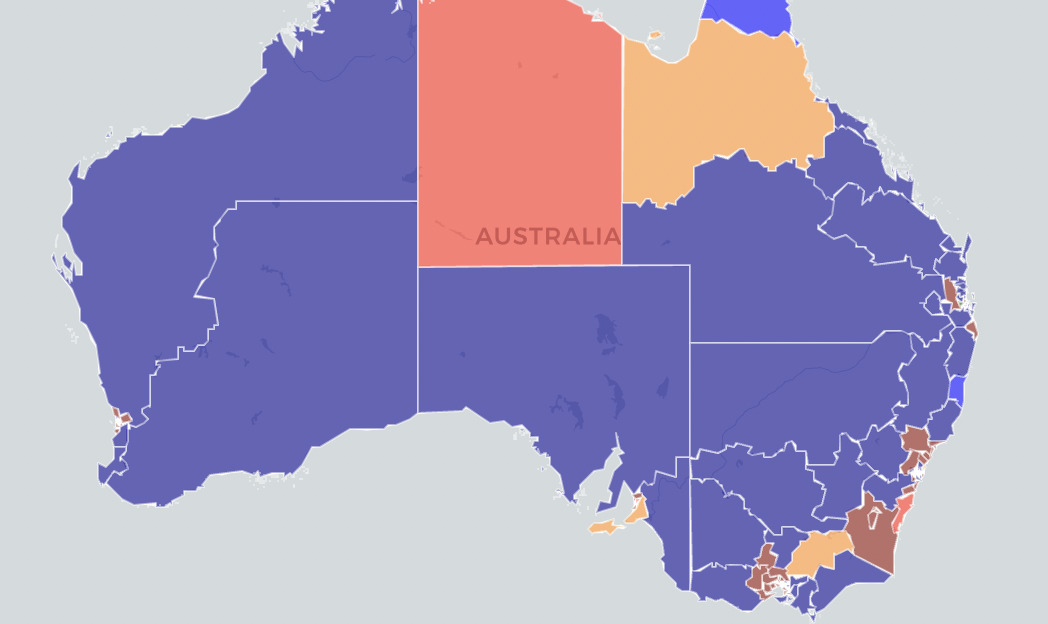I had wanted to do some analysis on the demographics of the 2022 election result, specifically looking at how swings correlated with various demographic groups within each electorate. But this is pretty much impossible to do right now, because we don’t have a complete two-party-preferred dataset, with about two dozen seats not reporting 2PP data.
Even where we have two-candidate-preferred data, in many seats we don’t have an equivalent result from 2019 for the calculation of a swing. Not only are we missing this data for about one sixth of the country, but it’s the part of the country where the most seats changed hands, and the biggest changes happened in general.
So while there will come a time for looking at swings and vote share changes, for now I’m going to focus on grouping electorates into demographic buckets, and seeing how the share of seats in each bucket for the main groups in parliament has changed before and after the election.
For this analysis I have treated the four outstanding seats as follows:
- Brisbane – Greens
- Deakin – Liberal
- Gilmore – Liberal
- Macnamara – Labor
First up, two demographics that tell similar stories: income and education. First up, I’ve split up electorates based on the proportion who have a bachelors degree or something higher. It’s worth reminding readers that we are not analysing how an individual voter with a particular education voted, but rather how electorates composed of various mixtures of educations voted.
The Coalition's losses were heavily concentrated at the top of the education spectrum. Eleven of seventeen losses were amongst the 28 seats with more than 25% of people with a bachelors degree or above. Another four were in the next group down, with only two in the lower two groups, which cover 88 out of 151 seats.
While Labor's gains were mostly concentrated amongst higher-education electorates, the Liberal losses at the top of the scale were mostly at the hands of the crossbench, who gained eight seats in this bucket.
The story is similar when you look at median income levels. This data came to me grouped into four buckets, but the upper group included very few seats, so I merged it with the group below it.
The Coalition previously held a majority of seats with a median weekly income of $800 or more, but now hold less than a quarter of these seats. Nine of the ten crossbench gains were in this category, along with six Labor gains.
The Coalition lost three seats to Labor in the largest middle group, while Labor actually is currently losing two seats in the low-income group. They've lost Fowler to an independent, and are narrowly behind in Gilmore. You'll find that Gilmore is often the exception in this data, and is currently the only change in a bunch of categories, assuming the Coalition hold on.
Next up. let's check in on the results per state. The crossbench gains are concentrated on the big east coast states, with nine gains across these three states, while Labor has only gained two seats (net, after they lost Griffith and Fowler). Labor's biggest success was in WA, where the Liberal Party dropped from ten seats to five. Labor needed to gain seven seats for a majority, and at the moment they are on track for exactly that. A majority of those seven seats came from WA.
Finally, probably the most interesting of these charts concerns the "demographic classifications" used by the AEC. The Commission classifies all electorates as inner metropolitan, outer metropolitan, provincial or rural, and have been doing so for a long time. If we look at seat changes across these four categories, the changes are stark.
Changes in provincial and rural Australia are very minor. Labor gained Robertson, a provincial seat, and on current numbers are behind in Gilmore, a rural seat.
The most dramatic changes were in inner metro Australia, with the Coalition losing twelve seats: five to independents, five to Labor and two to Greens. This spilled over to outer metropolitan seats, with crossbenchers winning Mackellar, Ryan and Fowler. The other changes in outer metropolitan seats were all in Perth and Adelaide.
I'll be back tomorrow with a longer historical perspective on the shifts between urban and rural Australia over the last 18 years.




Hi… thanks very informative..could we have a age breakdown as well please?
Cheers
Age data doesn’t really work that way.
The AEC is now reporting COVID votes. They heavily favour Labor.
Comments are closed.